Red annual flowers are bold, standout plants in the garden. Red adds vibrant energy, symbolizing strength, fiery spirit, and good luck. We’ve put together a list of striking red flowers to inspire your green thumb. The 10 red annual flowers we share here are popular plants for garden beds and container gardening, and as beautiful houseplants.
Planting annuals, which bloom for one growing season, is a great way to change the look of garden beds year to year. However, some of the red flowers on our list are tender perennials that also grow in colder climates as annuals.
“Tender” plants are those sensitive to the cold. Thus, a tender perennial won’t typically grow back the next season if temperatures get too low in its planted zone.
Many red annual flowers attract pollinators but don’t always attract bees. Why? Because bees can’t see the color red! However, hummingbirds and butterflies love red flowers of various shapes. After all, hummingbirds are particularly mesmerized by red blooms shaped like tubes or cones.
1. Tuberous Begonia

Fedotova Olga/Shutterstock.com
Botanical name: Begonia x tuberhybrida
Common names: begonia, tuberous begonia
USDA hardiness zones: 9 to 11
Sun exposure: full sun to partial shade
Mature size: up to 3 feet tall, 3 feet wide
Bloom time: mid-spring through fall
Flower colors: red, pink, white, orange
Tuberous begonias are shade-loving annuals that come in a wide range of colors and flower shapes. Red begonias do well in different containers, hanging baskets, and plant beds. In addition, these red annual flowers also love to grow indoors as houseplants. Tuberous begonias bloom in ruffled, single, or double flower clusters above burgundy or green, bushy foliage.
Water these annual flowers every 2-3 days, and be careful not to cause root rot from too much moisture. As heavy feeders, begonias stay healthier with consistent fertilization every couple of weeks.
Though hardiest in warmer growing zones, tuberous begonias grow well as annual flowers in many zones. So, if you want your begonia tubers to grow again (zones 9 to 11), dig up and store the tubers once the plants die. Wrap each tuber in newsprint or a paper bag and store in a cool, dry place over winter.
Tuberous begonias are just one variety of begonia that comes in red. Look for these additional begonia types for different shapes and sizes of blooms and foliage:
- Cane Begonia
- Rhizomatous Begonia
- Wax Begonia
2. Cockscomb

iStock.com/Tetiana Kolubai
Botanical name: Celosia cristata
Common names: cockscomb, woolflower
USDA hardiness zones: most zones as an annual
Sun exposure: full sun preferred
Mature size: up to 11 inches tall and wide (some varieties grow taller)
Bloom time: late summer through fall
Flower colors: red, pink, yellow, orange, white
Cockscombs are drought-tolerant annuals that produce showy, brain-like flowers on tall stems. These ornamental red blooms are popular in fresh flower arrangements.
Plant cockscombs in full sun and well-drained soil. Plus, they’re heat-loving plants that might also do well in partial shade. Deadhead the spent blooms for best plant performance.
The cockscomb plant is edible! For example, the stems, leaves, and blooms compliment recipes in different ways, especially soups and stews. Parts of the cockscomb are also used in herbal medicine applications for eye conditions like cataracts and blurred vision.
Always check with a trusted doctor or nutritionist first before consuming edible plants in case of allergies and food sensitivities.
3. Firecracker Plant
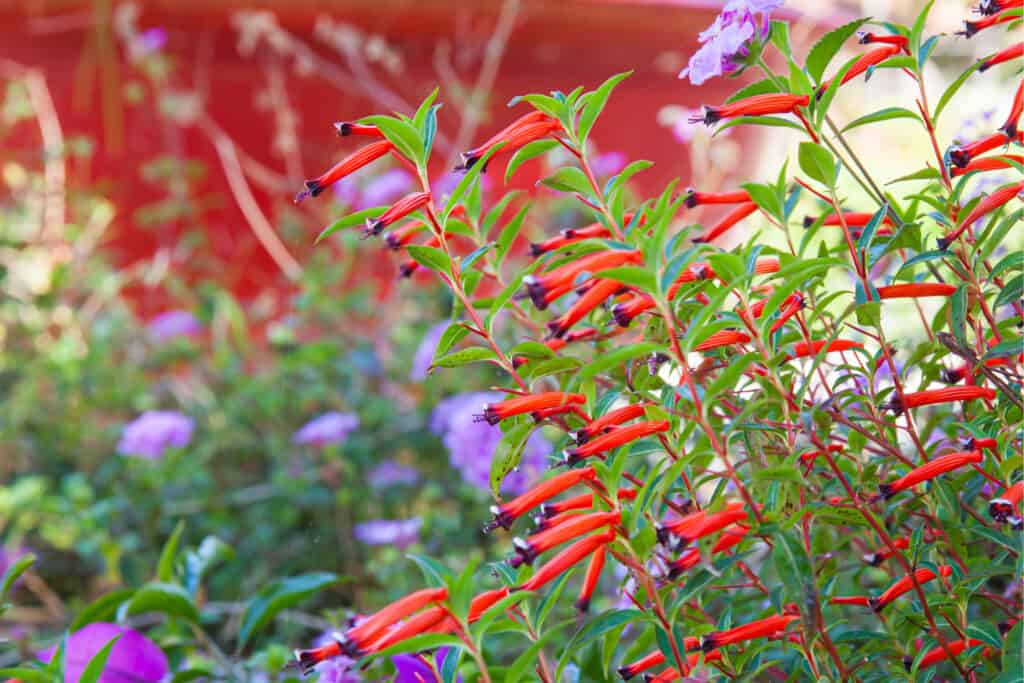
iStock.com/Minwan
Botanical name: Vermillionaire cuphea
Common names: cigar plant, firecracker plant
USDA hardiness zones: 9 to 11 (and some colder zones too)
Sun exposure: full sun preferred
Mature size: up to 2-3 feet tall and wide
Bloom time: late spring through fall
Flower colors: bright red-orange
The firecracker plant is a tropical annual that produces tubular, bright red and orange flowers that attract hummingbirds and butterflies. This plant is drought-tolerant but does not like the cold. Vermillionaire does best in full sun and is a good choice for growing in pots or as a bedding plant.
Though the hardiness zones are 9 to 11, the firecracker plant also thrives in colder zones during hot summer months. Red firecracker blooms are possible in zones as low as zone 5 (and probably lower) in mid to late summer.
Hummingbirds especially adore this red annual flower. Plant your firecracker flowers somewhat higher up for the bird’s easy access (like in containers on a deck) and close to hummingbird feeders. Try to place plants that attract hummingbirds where there’s a bit of protection from birds of prey.
4. Geranium

iStock.com/MayaAfzaal
Botanical name: Pelargonium x hortorum
Common names: geranium, zonal geranium, garden geranium
USDA hardiness zones: 10 to 11
Sun exposure: full sun to partial shade
Mature size: up to 3 feet tall, 3 feet wide
Bloom time: spring through fall
Flower colors: red, pink, orange, white, purple
Geraniums are popular annual flowers that come in many colors. Red geraniums from plant suppliers are usually hybrids perfect for growing in pots, window boxes, or bedding plants. The showy geranium produces fluffy clusters of star-shaped blooms.
This low-maintenance annual flower prefers full sun but will also do well in partial shade. Water this plant consistently to keep the soil slightly moist. Fertilize geraniums every two weeks with a balanced fertilizer to keep the plants blooming.
5. Impatiens
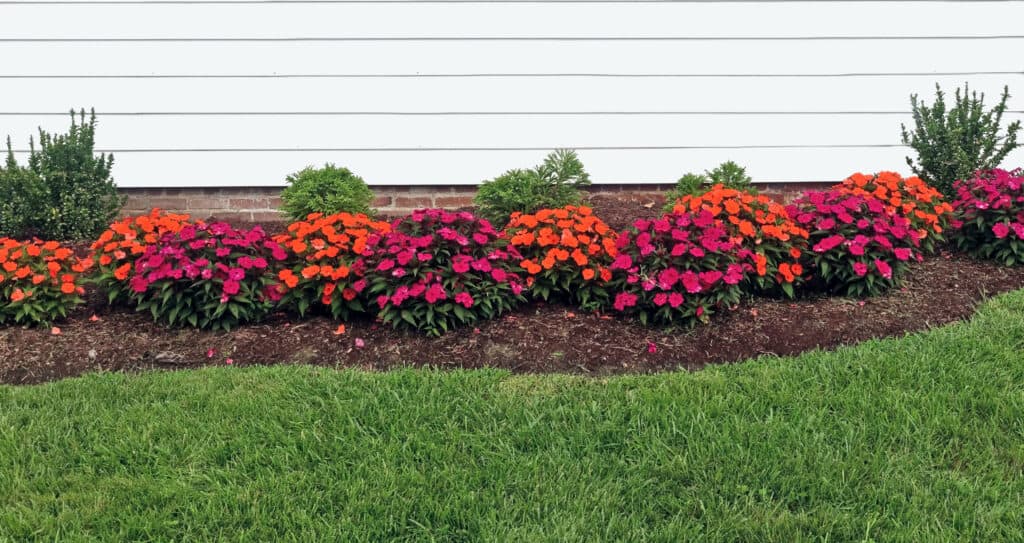
iStock.com/Joe_Potato
Botanical name: Impatiens walleriana
Common names: busy Lizzie, impatiens
USDA hardiness zones: 10 to 11
Sun exposure: partial shade to full shade
Mature size: up to 6-24 inches tall and wide
Bloom time: spring through fall
Flower colors: red, pink, lavender, purple, white, orange, bi-color
Impatiens are annual flowers that grow well in shady areas. Red impatiens prefer well-drained soil and will not tolerate drought conditions. If you fertilize these red annual flowers every 1-2 weeks, they will bloom like champs.
Unlike other plants that need more sun, impatiens are beautiful plants for containers on covered porches and in beds near trees. And though ideal for hardiness zones 10 to 11, impatiens perform beautifully as annuals in colder zones too.
If your impatiens get leggy around mid-summer, prune them back to about 3-4 inches tall for strong regrowth.
6. Million Bells
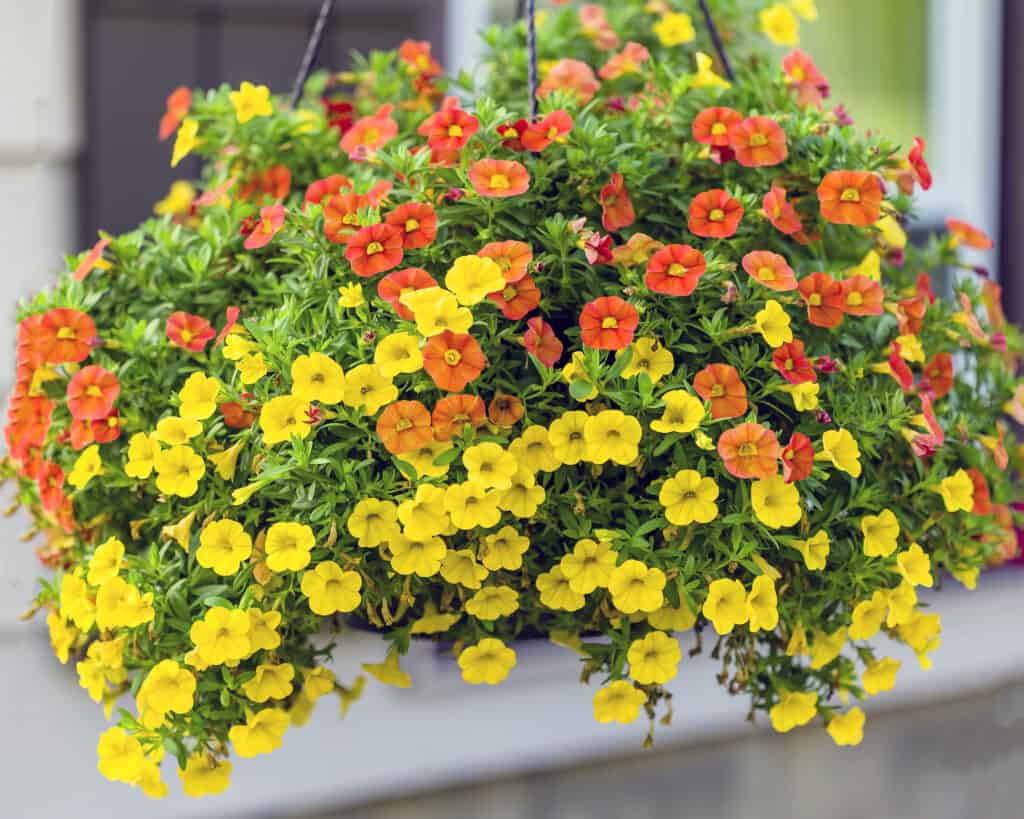
iStock.com/Mark R Coons
Botanical name: Calibrachoa x hybrid
Common names: million bells, trailing petunia
USDA hardiness zones: 10 to 11
Sun exposure: full sun to partial shade
Mature size: up to 6 inches tall and 2 feet wide
Bloom time: spring through fall
Flower colors: red, pink, purple, white, orange, yellow
Million bells are trailing annual flowers that produce a lot of small, bell-shaped blooms. They look a bit like tiny petunias. These hybrid garden flowers are perfect for growing in pots, hanging baskets, or bedding plants in sunny garden plots. Million bells – also called trailing petunias – are tender perennials grown as annuals in many hardiness zones.
Red million bells don’t require deadheading to produce lots of blooms from spring through the first frost. Let the top 1-2 inches of well-draining soil go dry before each watering. Watch for wilted leaves that could indicate root rot from overwatering. Million bells love extra nutrients from fertilizer every two weeks.
As a tender perennial, million bells grow best in hardiness zones 10 to 11 but also do well as annuals in colder zones.
7. Petunia
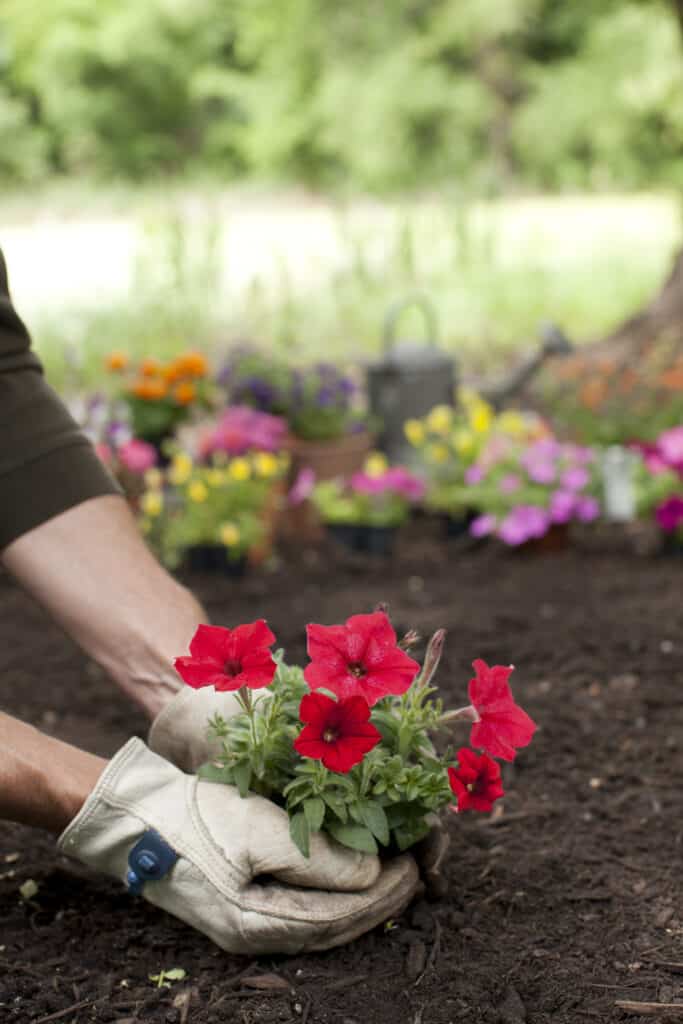
iStock.com/Liliboas
Botanical name: Petunia x atkinsiana
Common names: petunia
USDA hardiness zones: 9 to 11
Sun exposure: full sun preferred
Mature size: up to 18 inches tall, 4 feet wide
Bloom time: spring to fall
Flower colors: red, blue, white, yellow, pink, purple, bi-color
Red petunias are eye-catching annual flowers for gardens and containers. They’re easy to grow, inexpensive starter plants and available at most garden centers. Petunias have delicate blooms shaped like funnels that look charming in sunny window boxes from spring through fall.
Plant petunias in well-drained soil, watering regularly to keep the soil moist. These red annual flowers thrive in full sun, enjoy hot climates, and tolerate humidity. If you want them to bloom more often, prune them back regularly or when you notice the plants getting leggy.
Petunias come in a variety of red shades. Look for these and more red petunias wherever you buy your garden plants:
- Aladdin Red
- Capri Rose
- Double Valentine
- Hurrah Red
8. Poppy
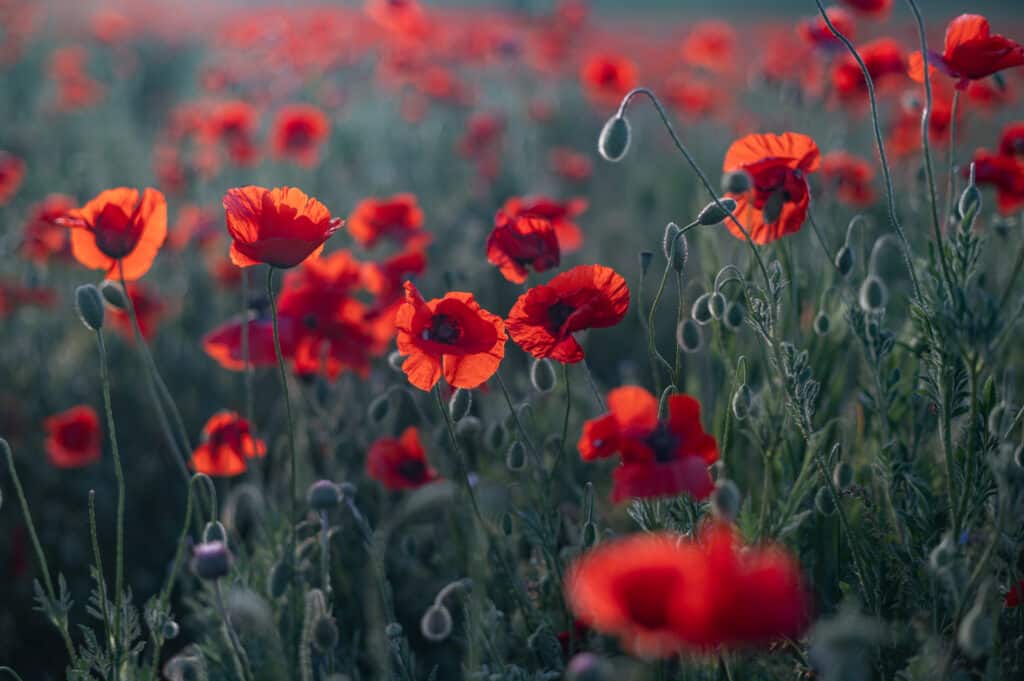
iStock.com/grThirteen
Botanical name: Papaver somniferum
Common names: poppy, opium poppy, cherry glow poppy
USDA hardiness zones: 3 to 8
Sun exposure: full sun to partial shade
Mature size: up to 3 feet tall, 1 foot wide
Bloom time: spring through summer
Flower colors: red, pink, purple, white, orange
Poppies are low-maintenance annual flowers that attract butterflies. The poppy’s dynamic red blooms usually appear in spring and continue through June. This red annual flower is tolerant of drought conditions, plus it is deer and rabbit resistant.
There’s a reason wild animals avoid this plant. Poppies are toxic for humans and animals. So, wear gloves when handling poppy plants, and don’t let pets or children put these plants in their mouths.
Poppies perform best in full sun but can also handle partial shade. This annual garden flower needs well-drained, loamy soil and doesn’t do well with overwatering. As for garden beds, water poppies every few days or when about the top inch of their soil is dry.
9. Lady in Red Salvia
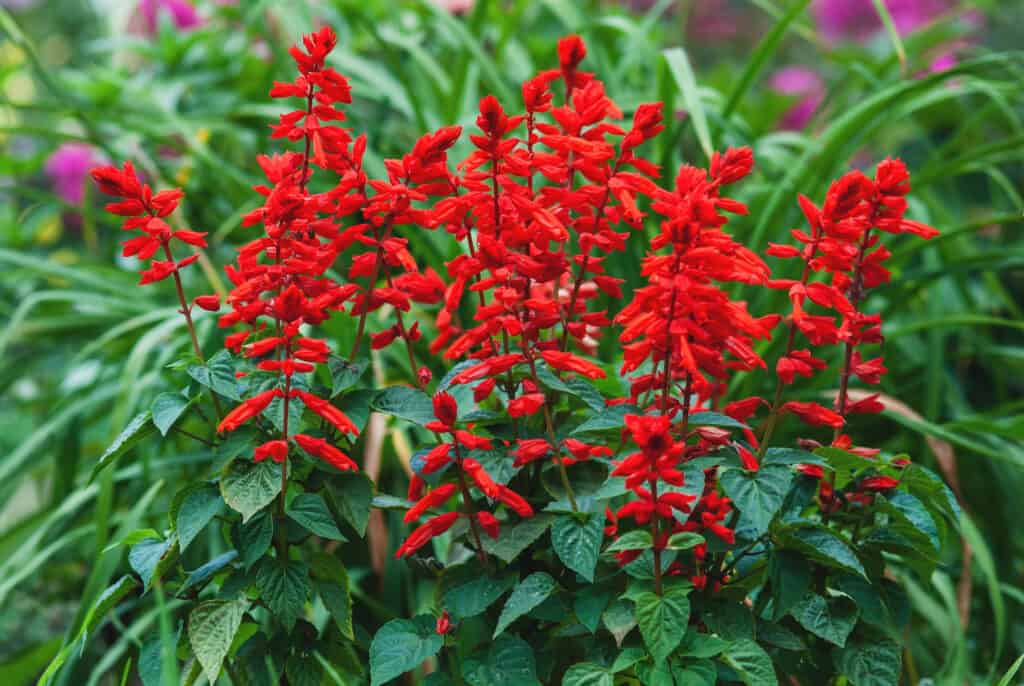
iStock.com/Nadya So
Botanical name: Salvia coccinea
Common names: lady in red, blood sage, scarlet sage, tropical sage
USDA hardiness zones: 8 to 11
Sun exposure: full sun to partial sun
Mature size: up to 2-3 feet tall and wide
Bloom time: summer through fall
Flower colors: red
Lady in Red salvia is another red annual flower that hummingbirds adore. So, it’s no surprise hummingbirds flock to this salvia’s tube-shaped flowers, but butterflies love them too. This bushy plant with long blooming stalks grows rapidly in hot and humid climates.
Red salvia flowers prefers full sun to light shade and grows as annuals in most hardiness zones. These garden showstoppers look elegant in containers and garden borders.
As you might guess by one of its names, scarlet sage, this salvia plant has an appealing sage fragrance. But don’t eat it! This salvia variety is not edible. However, deer won’t eat salvia either. So, planting salvia and other deer-resistant plants helps keep deer out of your garden.
10. Zinnia
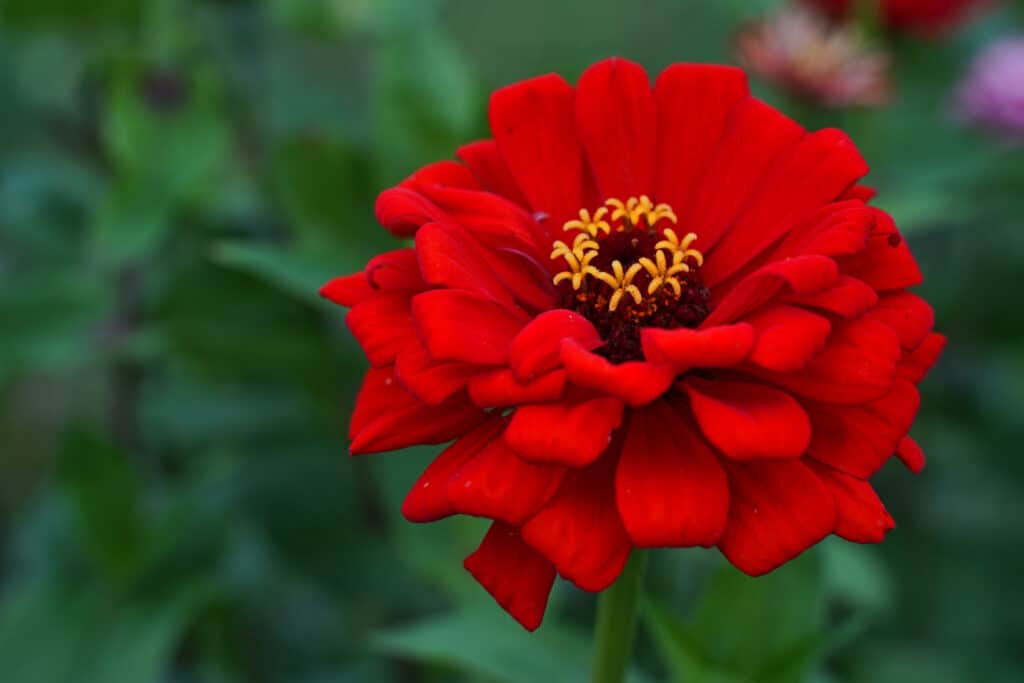
iStock.com/Kathy Reasor
Botanical name: Zinnia elegans
Common names: zinnia, common zinnia, elegant zinnia
USDA hardiness zones: 3 to 10
Sun exposure: full sun preferred
Mature size: up to1-3 feet tall and wide
Bloom time: summer through fall
Flower colors: red, pink, purple, white, orange, yellow, bi-color
Zinnias are beloved for their beauty and sturdiness as cut flowers. Plant red zinnias for their standout presence and ease of growth. Zinnia blooms look similar to pom-poms, with slightly different petal shapes (like stars or domes) depending on the variety.
Grow your red zinnias in fertilized and well-drained soil, preferably covered with compost. Additionally, water these annual flowers 2-3 times a week or enough to keep the soil moist but not soggy.
The common zinnia is non-toxic to animals. Unfortunately, that means your zinnias might become snacks for rabbits and slugs. In addition, insects that love to munch on zinnias include aphids and Japanese beetles.
Red zinnias are available in many different cultivar varieties. Look for the cultivars below and more at your favorite garden centers:
- Benary’s Giant Scarlet
- California Giant (in red)
- Double Zahara Cherry
- Dreamland Scarlet
- Holi Scarlet
Plant Red Annual Flowers for Luck and Joy
From deep scarlet to light rose hues, red annual flowers make a bold statement in any garden bed. Add vibrance and warmth to windowsills with potted begonias and a vase full of zinnias. Or dazzle the hummingbirds with flower beds full of firecracker plants and ‘Lady in Red’ salvia. Whatever red garden flowers you choose, we hope they all bring you great luck and many weeks of flower-lovin’ joy!
Up Next:
- How to Stop Rabbits from Eating Your Plants and Flowers
- What Flowers Attract Butterflies
- What Do Hummingbirds Eat?
Sources:
https://gardenbeast.com/cockscomb-guide/
https://www.gardenia.net/plant/cuphea-vermillionaire
https://www.gardendesign.com/annuals/impatiens.html
The post 10 Red Annual Flowers: Vibrant Showstoppers appeared first on AZ Animals.
from Animal News, Facts, Rankings, and More! - AZ Animals https://ift.tt/Foxqmgj